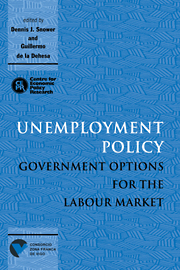Book contents
- Frontmatter
- Contents
- List of figures
- List of tables
- Preface
- Acknowledgements
- List of conference participants
- 1 Introduction
- PART ONE GENERAL POLICY ISSUES
- PART TWO DEMAND MANAGEMENT AND SUPPLY-SIDE POLICY
- PART THREE SUBSIDISING EMPLOYMENT AND TRAINING
- PART FOUR LABOUR MARKET REGULATIONS
- PART FIVE POLICY, JOB REALLOCATION AND THE UNEMPLOYMENT–PRODUCTIVITY RELATION
- PART SIX COMPARING UNEMPLOYMENT POLICIES
- 16 Unemployment in the OECD and its remedies
- Discussion
- Discussion
- 17 The unemployment and welfare effects of labour market policy: a comparison of the USA and the UK
- Discussion
- Discussion
- Index
Discussion
Published online by Cambridge University Press: 07 September 2010
- Frontmatter
- Contents
- List of figures
- List of tables
- Preface
- Acknowledgements
- List of conference participants
- 1 Introduction
- PART ONE GENERAL POLICY ISSUES
- PART TWO DEMAND MANAGEMENT AND SUPPLY-SIDE POLICY
- PART THREE SUBSIDISING EMPLOYMENT AND TRAINING
- PART FOUR LABOUR MARKET REGULATIONS
- PART FIVE POLICY, JOB REALLOCATION AND THE UNEMPLOYMENT–PRODUCTIVITY RELATION
- PART SIX COMPARING UNEMPLOYMENT POLICIES
- 16 Unemployment in the OECD and its remedies
- Discussion
- Discussion
- 17 The unemployment and welfare effects of labour market policy: a comparison of the USA and the UK
- Discussion
- Discussion
- Index
Summary
Introduction
The rapid decline in demand for unskilled workers in the OECD countries is causing serious problems, particularly in those parts of the world where the rate of decline in demand is significantly outpacing the rate of decline in supply. Minford's chapter is concerned with both the causes and consequences of this demand collapse. Section 2 presents a crudely calibrated world general equilibrium model with two countries (North, South), four goods, three of which are traded, and five factors, two being mobile. This model is simulated in order to investigate the implications of improvements in the technology of the South. The main focus is on the consequence for the wages of the skilled and unskilled in the North.
Sections 3–4 look at the ‘trade versus technology’ literature. This literature is concerned with the relative importance of trade globalisation and skill-biased technical change in causing the decline in unskilled demand. Minford comes out strongly in favour of trade globalisation as the key driving force. Finally, sections 5–6, there is an extensive analysis of the best welfare policy to cope with the problems of low pay and poverty induced by the decline in unskilled wages or employment.
Trade versus technology and the Minford model
The key problem with which Minford is concerned is the quantitative importance of ‘North–South’ trade developments in explaining the collapse in demand for unskilled workers in the North and the consequent worsening of their pay and employment prospects.
- Type
- Chapter
- Information
- Unemployment PolicyGovernment Options for the Labour Market, pp. 541 - 544Publisher: Cambridge University PressPrint publication year: 1997
- 2
- Cited by



